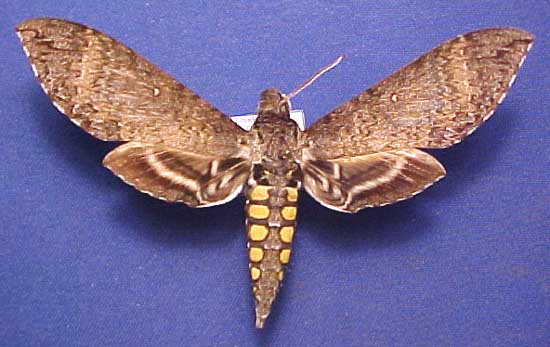
Manduca diffissa tropicalis by John Vriesi.
This site has been created by Bill Oehlke.
Comments, suggestions and/or additional information are welcomed by Bill.
TAXONOMY:
Family: Sphingidae, Latreille, 1802 |
|
|
Updated as per
AN ANNOTATED CHECKLIST OF THE SPHINGIDAE OF BOLIVIA, October 2007 Updated as per Fauna Entomologica De Nicarauga, November 2007 Updated as per personal communication with Ian Kitching Updated as per CATE (description); February 12, 2011 Updated as per Heteroceres de Guyane Francaise (Kaw, August, November); February, 2011 Updated as per Funet (Omai, Guyana), February, 12, 2011 Updated as per Bold Systems (Venezuela, French Guiana, Suriname, Colombia, Ecuador, Peru, Bolivia, Brazil); February 2011 |

This site has been created by Bill Oehlke.
Comments, suggestions and/or additional information are welcomed by Bill.
TAXONOMY:
Family: Sphingidae, Latreille, 1802 |
It apparently flies as far north as
Nicaragua: Esteli, Granada.
Distinguished from Manduca diffissa petuniae in having the forewing upperside darker, less yellowish. Forewing upperside with ground colour variable, some individuals distinctly more russet than others; discal area sometimes rather black, contrasting with the paler basal and posterior areas. CATE
Ian Kitching writes, "At present (October 2007), the subspecies
situation in Manduca diffissa is rather confused.
"Manduca diffissa diffissa is a small grey subspecies from SE Argentina, Uruguay and Mato Grosso do Sul, Brazil. It might be a separate/distinct species?
Rothschild & Jordan listed M. d. diffissa from Paraguay but I suspect these would be better placed as M. d. petuniae
(though I have not checked closely).
"Manduca diffissa petuniae is generally (but not always) a pale
brown form from SE Brazil as far north as Minas Gerais (and probably
in the Iguazu, Argentina area).
"Manduca diffissa tropicalis is a larger, darker form from Minas
Gerais to Colombia and northeastern Brazil. However, to quote R&J: 'The ground colour of the
forewing is, however, variable, some individuals being decidedly more
russet than others, though not so pale as petuniae'."
"Manduca diffissa mesosa is a form from Salta and Tucuman in
northern Argentina (and probably southern Bolivia) that is
intermediate between tropicalis and petuniae(!).
"Manduca diffissa zischkai is a high altitude subspecies from
Bolivia that may be a separate species.
"Manduca diffissa ssp in eastern Ecuador is decidedly greenish,
and the distinction between this and Manduca mossi is
difficult to determine and is under study by Jean Haxaire (it was
being studied by Jean-Marie Cadiou and me until his untimely
passing).
"I doubt that the distinction between mesosa, petuniae and
tropicalis will hold, but maybe DNA barcoding will suggest how
things should be organized."
Specimens have been taken in Kaw, French Guiana in August and November.

Use your browser "Back" button to return to the previous page.
Return to Sphingidae Index
Return to Sphingini Tribe
This page is brought to you by Bill Oehlke and the WLSS. Pages are on space rented from Bizland. If you would like to become a "Patron of the Sphingidae Site", contact Bill.
Please send sightings/images to Bill. I will do my best to respond to requests for identification help.
Enjoy one of nature's wonderments: Live Saturniidae (Giant Silkmoth) cocoons.
 Show appreciation for this site by clicking on flashing butterfly to the left. The link will take you to a page with links to many insect sites. |